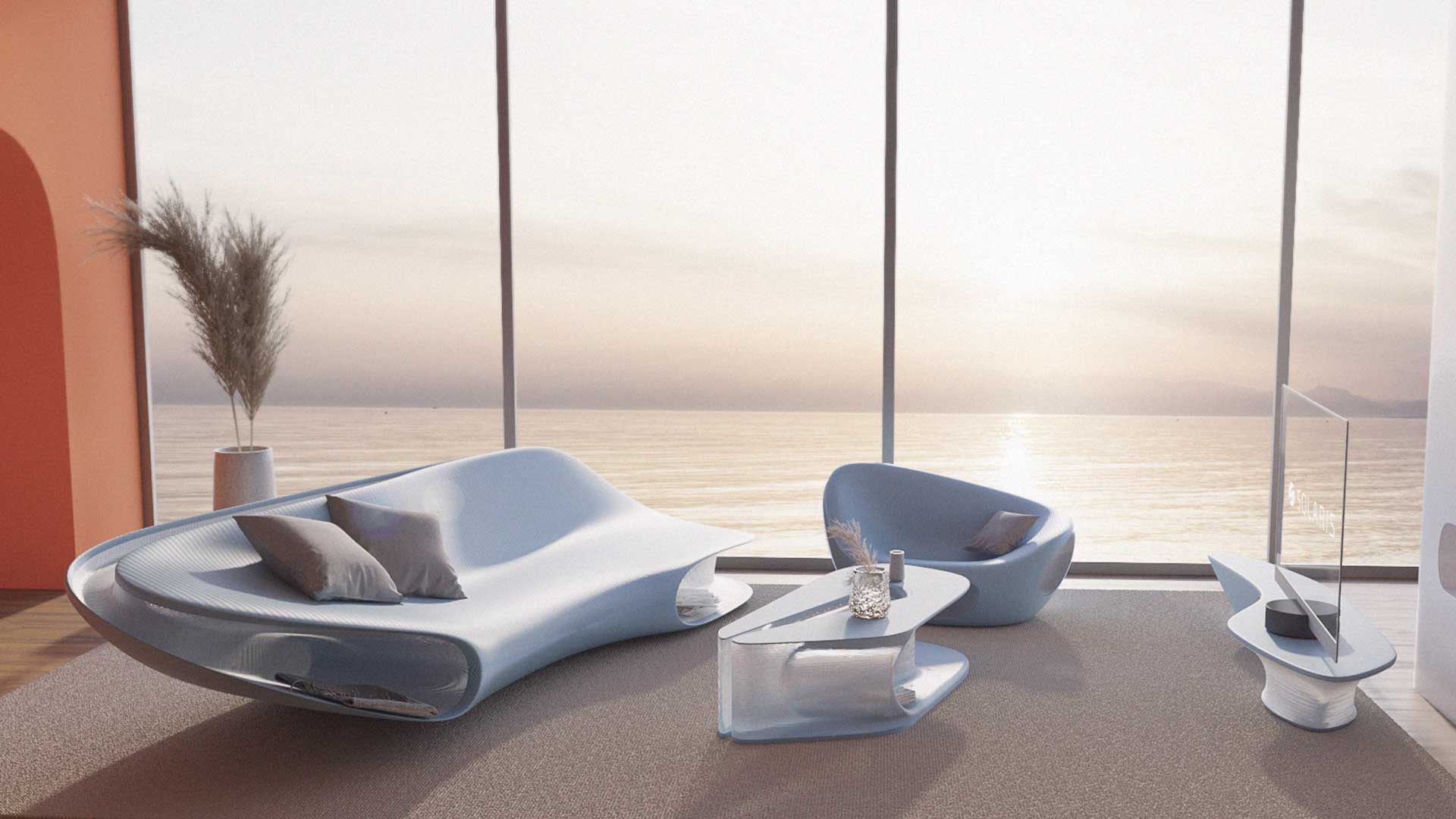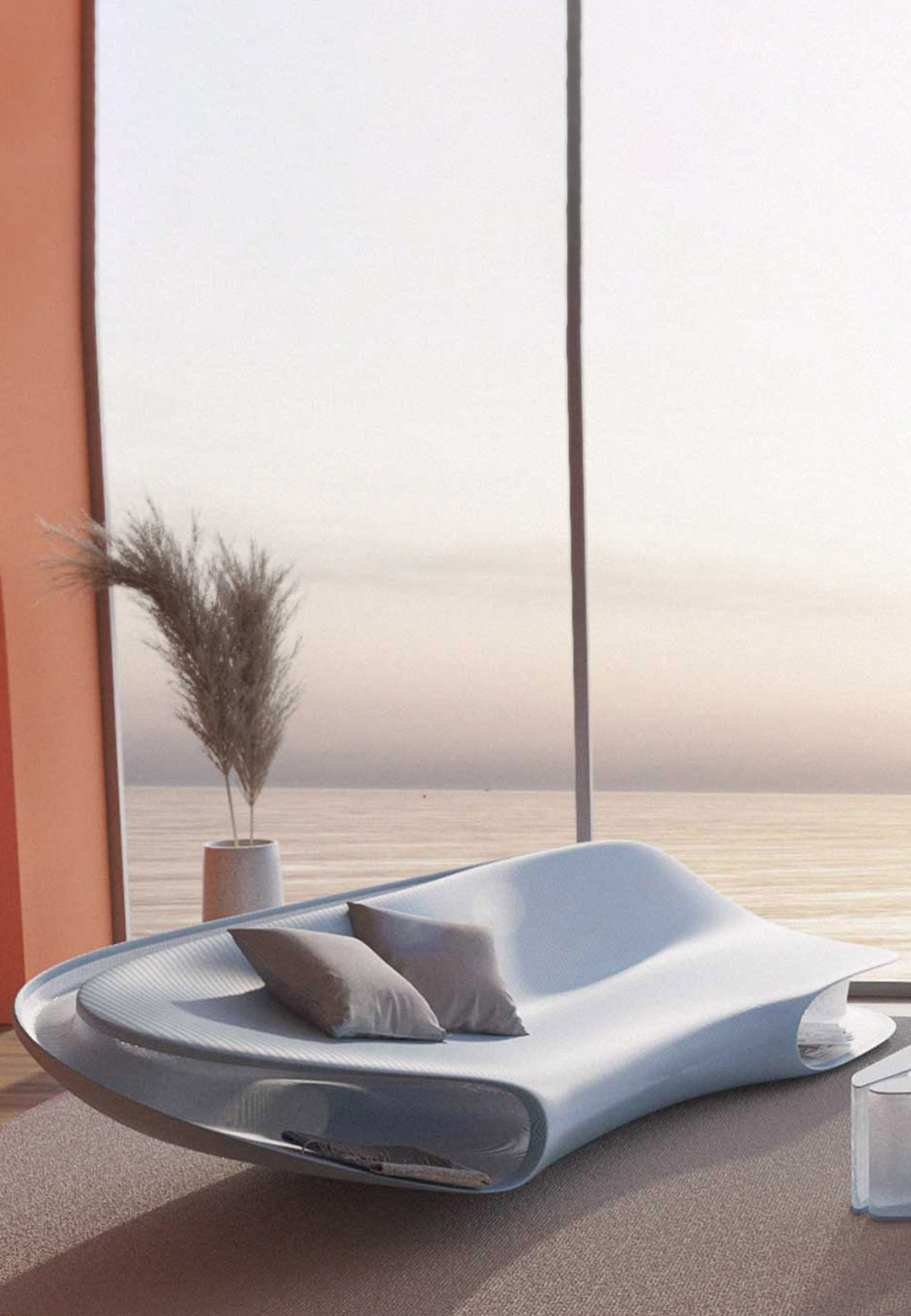A paradigm change in the interior and furniture design field was introduced by adopting 3D printing. The blend of cutting-edge production methods and creativity brings to fruition one-of-a-kind, adaptable product designs that consider different requirements and conditions. With the help of this ground-breaking technology, it is now possible to design custom furniture completely tailored to preferences, tastes, and needs. One of its most distinctive characteristics is the potential of 3D printed furniture to transcend the limitations of conventional production processes. Complex geometries, elaborate structures, and unusual forms can easily be achieved using 3D printing technology. Designers can dive deep into unexplored territories and completely transform the appearance of spaces by using 3D printed furniture to create everything from clean, minimal designs to bold avant-garde designs.
From monolith chair designs to minimalistic designs, designers have crafted eco-friendly pieces adapting the usage of 3d printing arching a step closer to sustainable furniture design.
STIR enlists 10 innovative 3D printed furniture designs that juxtapose the advancements of 3D printing with sustainable design.
Honoka - Tatami Refab
At SaloneSatellite 2023, projects by representatives of many origins and provenances covered a range of geographical latitudes and design philosophies. Honoka from Japan won the First Prize for his Tatami Refab, which combines 3D printing technology and recycled tatami. This multifaceted endeavour brought back traditional markings and culture into residential settings and daily life. Tatami production and consumption are dwindling over time. The Tatami Refab Project uses 3D printing to reintegrate the Tatami into contemporary society.
STRATUM by The New Raw
The largest monolithic piece the creative duo has created to date makes the entire space vibrate. It turns, curves, folds, and unfolds in a variety of heights and widths, serving as seating, planters, a high working desk, and a leaning table in accordance with the specifications of DENC architects, who were in charge of the entrance interior design. The project resembles rock formations by creating a new sort of "stone" out of 880 kg of plastic garbage using a complex layer-to-layer 3D sculpture technique. In Stratum, a new layer starts to deposit on top of the previous one as it hardens into its final enormous shape, much to how real layers of fossil debris are compacted and lithified through time. Due to subsequent movement, while the sediments were still soft, certain strata had curved shapes.
Elemental series by Guillaume Credoz for Post Industrial Crafts
The Elemental Series, created by architect Guillaume Credoz for Post Industrial Crafts, actualises the most recent development in large-scale robotic 3D printing. Only the side tips of the Elemental pieces are flat; all other surfaces are voluptuously formed for both comfort and the forces at work in their skeleton structures. As a result, the very distinctive shapes produced by generative design are obviously given a sense of sturdiness by the ample organic framework. The entire collection is created using unorthodox 3D printing code and hardware, in which layers are not parallel, resulting in convergent lines whose thickness decreases towards the back seat, providing a fascinating perspective effect within the materiality and process of the pieces themselves.
Oceana by Karim Rashid
Karim Rashid's Oceana Collection is an environmentally responsible move towards holistic design. OCEANA Collection is a component of Solaris Community's "Closing the Loop" project, which aims to reduce the amount of plastic waste in the ocean. Karim was motivated by the programme to design a sculptural, more comfortable world using advanced ecological materials. The Circular Ocean Plastic Project investigates creative ways to transform marine plastic waste into high-end, long-lasting items. The techniques employed, including the disintegration and pelletization of the polymers and 3D printing, create superior materials that can be utilised for almost anything and endure harsh conditions.
The Urlo series by Lorolori Studio
The Urlo series by Lorolori Studio is a collection of 3D printed chairs and side tables that were inspired by Munch's painting "The Scream." The feelings that are typically viewed as negative, such as fear and despair, are celebrated by Urlo. The Lorolori studio is a multidisciplinary organisation that combines furniture design and digital art. It strives to create projects using a narrative approach that not only emphasises the usability of the items but also conveys emotions.
BOUCLE* Chair by LYLA design
The 3D printed BOUCLE* (French for loop or curl) Chair by Berlin/Paris-based interior design studio LYLA Design is inspired by the lifetime of PET-G. Its interaction and deconstruction are varied and fascinating to watch since it drifts from one shape to another. The LYLA software was used to create LYLA's BOUCLE*, making it simple to alter and defy limitations imposed by conventional design tools. giving everyone access to a design tool and personalising everyday existence.
Apophenia collection Aleksandr Delev
A psychogeographical environment of apophenic forms is depicted in this collection of objects, which leans on rocks, clouds, and digitally distorted pictures. They are a component of a bigger body of work that constitutes a plot that includes casting, coincidences and an unexpected conclusion. A 3D printer and software are used to digitally create some furniture pieces' details and components, which are then serially replicated using a mould. Therefore, a combination of fortuitous casts and 3D elements make up these furniture objects. Combining organic shapes with semi-transparent and vibrant colour options aims to enhance the material's sensuous properties. Every piece of furniture is different, and some of them contain the aforementioned serial components.
Phantasmagorical Skin series Chair by sekisai
An intriguing visual effect is produced by sekisai's "Phantasmagorical Skin," a unique 3D printing technology that changes colour based on the viewing angle. It creates a sensation of transforming contact with the environment by immersing the user in pulsating life, such as shifting flower colours and soaring butterflies. Aiming to stimulate people's sensitivities through encounters with items and to foster the development of their hearts and lifestyles, the collection focuses on the function of design in "colouring" people's lives.
Rio by Morgan Studio & Studio INTEGRATE
The Rio collection was created by Morgan Studio in collaboration with studio INTEGRATE which explores fusing the craft of today with the craft of tomorrow. The set includes a number of dining/meeting chairs with 3D printed, upholstered, or wooden backrest choices. An elaborate backrest and arm are made using 3D printing technology and a mathematical algorithm. Polyamide printing was used.
The Plumon Collection side table
The Plumon collection, designed by Patricia Urquiola for Spanish brand Kettal, is based on the concept of clothing, dressing and undressing furniture. The tables in the collection are made using an innovative method: 3D stoneware printing. With the ability to customise each object so that no two are alike, 3D stoneware printing offers an unprecedented level of productivity and creative freedom. Additionally, because no mould is needed and the parts are fired at a low temperature, the process is sped up, allowing for a more flexible and dynamic approach to the project.
Text by Ria Jha






 Sign in with email
Sign in with email








What do you think?